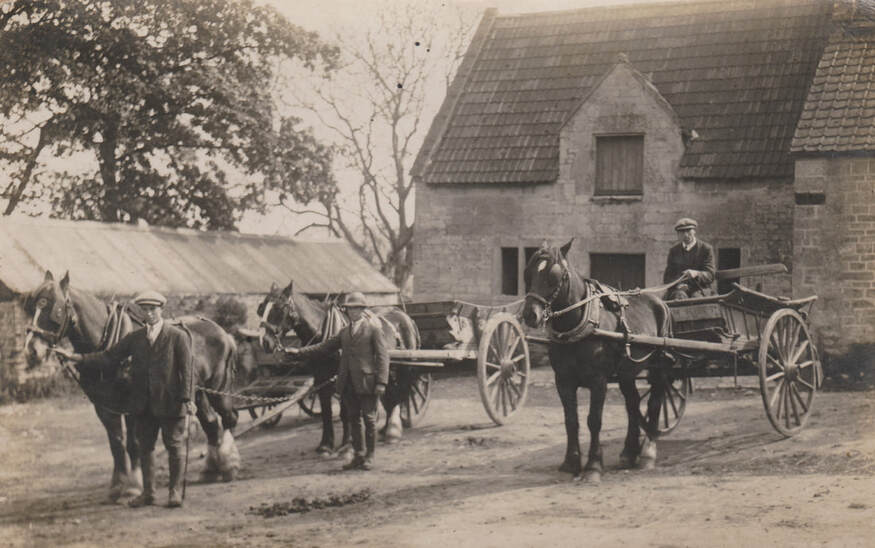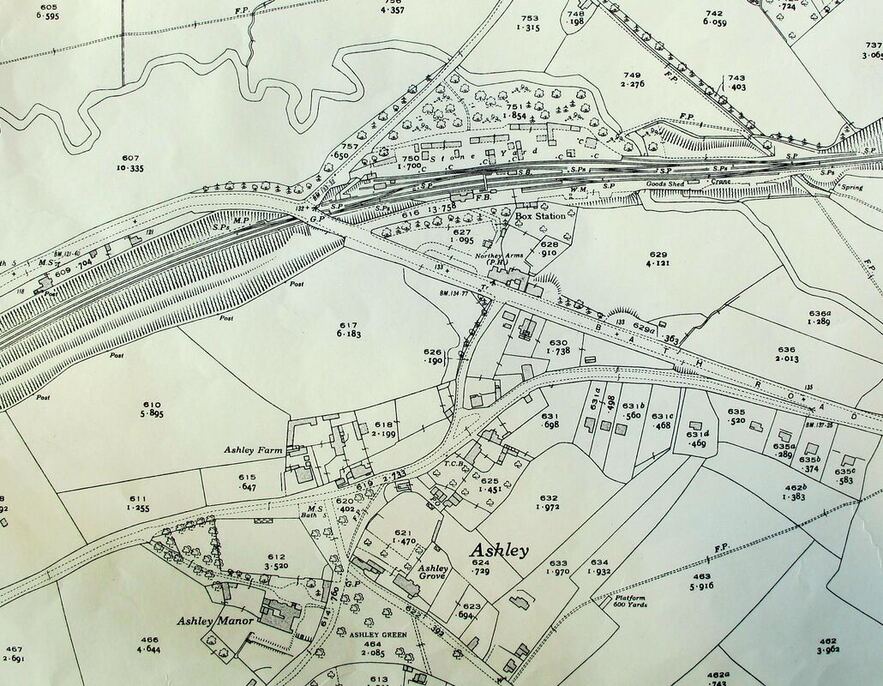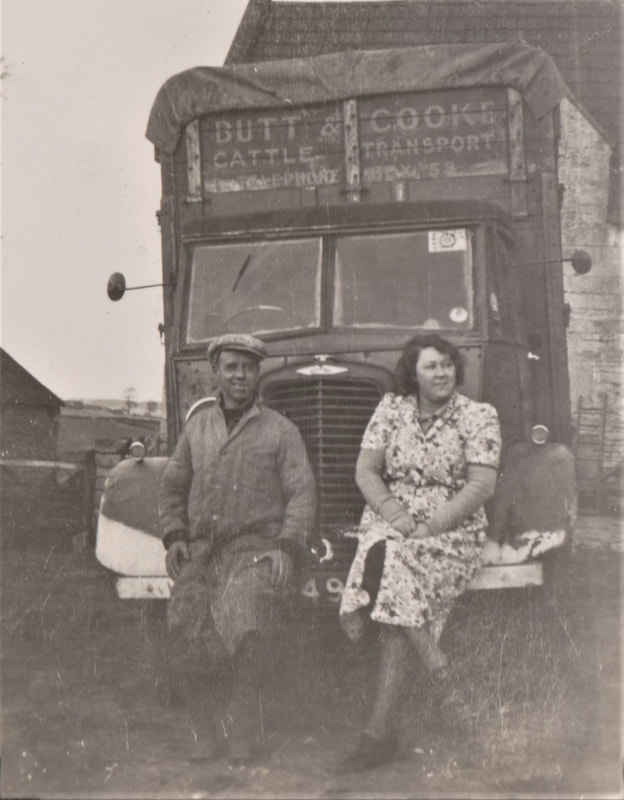Ashley Farm and the Rise of Farmhouses Alan Payne July 2020
What is a farm? We currently define it as an enclosed area of land and buildings supporting husbandry, but it didn’t always mean that. The word originally meant a fixed payment for sub-contracting the collection of taxes (from the medieval Latin firma meaning a defined amount of payment). Only in the early 1500s did it come to mean a fixed rent for land, later meaning land itself. There are several properties called farm along Ashley Lane – Spencer’s Farm, Ashley Farm, Upper Sheylor’s Farm and Lower Sheylor’s - which seems rather unusual for a single road. We know that the area became stuck in time after 1841 when a dog-leg was built to connect with Box Railway Station, Ashley, which by-passed the traditional road. To understand how the area was deliberately created into small farmsteads, we need to consider the role of Anthony Long of the family who owned South Wraxall Manor.
Long Family at Ashley
Although the family was very wealthy, Anthony didn’t inherit the bulk of the fortune, being the fourth of seven sons, sent out into the world to make his own way. His income in Ashley partly derived from his control of local government. As Justices of the Peace in Tudor times, the Box family exploited tax advantages (monopolies) and local opportunities. In 1555 Anthony Long rebuilt Ashley Manor, although the house was small compared to today, and Ashley Farm was just another source of his income as a landlord. Anthony is still recalled in the village today in an effigy in Box Church with the inscription: Here lyeth the body of Anthony Long, Esqr, buried 2nd of May 1578.
The family’s income also came from enclosing areas of land and letting them out to individual tenants. Francis Allen's 1630 map shows the remains of medieval field-strip farming, where the local residents agreed to farm jointly, all growing the same crops and pooling resources to harvest them. There are some along Ashley Lane beyond the Grove site; others off Doctor's Hill; and more to the west of Wormcliffe. But these were the exception on the map and most of the land had already been enclosed into small fields averaging perhaps six or seven acres. A number of houses in the area have the name Croft = land enclosed as a private house out of a larger holding. There is Ashley Croft, Crofton, Stonecroft, Elmscroft and Croft Cottage. Some are the whim of modern owners but others harken back to the old field name. Francis Allen's map gives field names of Little Croft, Burrow Crofts, Oate Croft and Burcow Croft.
Architectural historian, Julian Orbach records that Ashley Farmhouse was probably built in 1600s and the adjacent barn in 1652, so presumably they were built by Long family.[1] It is sometimes called a tithe barn but it may be fanciful to attribute it to a monastic estate. According to English Heritage, exactly how barns in general were used in the Middle Ages is less well understood than might be expected, and the subject abounds with myths (for example, not one of England's surviving architecturally impressive barns was a tithe barn, although such barns existed).
Although the family was very wealthy, Anthony didn’t inherit the bulk of the fortune, being the fourth of seven sons, sent out into the world to make his own way. His income in Ashley partly derived from his control of local government. As Justices of the Peace in Tudor times, the Box family exploited tax advantages (monopolies) and local opportunities. In 1555 Anthony Long rebuilt Ashley Manor, although the house was small compared to today, and Ashley Farm was just another source of his income as a landlord. Anthony is still recalled in the village today in an effigy in Box Church with the inscription: Here lyeth the body of Anthony Long, Esqr, buried 2nd of May 1578.
The family’s income also came from enclosing areas of land and letting them out to individual tenants. Francis Allen's 1630 map shows the remains of medieval field-strip farming, where the local residents agreed to farm jointly, all growing the same crops and pooling resources to harvest them. There are some along Ashley Lane beyond the Grove site; others off Doctor's Hill; and more to the west of Wormcliffe. But these were the exception on the map and most of the land had already been enclosed into small fields averaging perhaps six or seven acres. A number of houses in the area have the name Croft = land enclosed as a private house out of a larger holding. There is Ashley Croft, Crofton, Stonecroft, Elmscroft and Croft Cottage. Some are the whim of modern owners but others harken back to the old field name. Francis Allen's map gives field names of Little Croft, Burrow Crofts, Oate Croft and Burcow Croft.
Architectural historian, Julian Orbach records that Ashley Farmhouse was probably built in 1600s and the adjacent barn in 1652, so presumably they were built by Long family.[1] It is sometimes called a tithe barn but it may be fanciful to attribute it to a monastic estate. According to English Heritage, exactly how barns in general were used in the Middle Ages is less well understood than might be expected, and the subject abounds with myths (for example, not one of England's surviving architecturally impressive barns was a tithe barn, although such barns existed).
Grand Residence but Poor Farm
In the early 1700s, the Northey family had acquired Ashley Farm, possibly buying it from the Longs. It was just an investment and they leased the property to tenants. The farmhouse appears to have had several short-term tenants in the early 1800s. In 1834 William Rogers is said to be at Ashley Farm and later the family occur at Ashley Grove. Around the year 1840 Joseph Pocock is listed there, although we know the family had their main holding at Sheylor's Farm. Ashley Lane became an anachronism after 1841 when the road to Bath was looped via the railway station. The reason why there are so many farm names along Ashley Lane is that the road became set in time without the subsequent redevelopment that occurred in central Box.
In the years 1851 to 1861 Samuel Pinchin (b 1789), who called himself a landed proprietor and retired miller lived in Ashley Farm with his wife Hannah Pinchin (b 1790 Frome) after they had moved from Townsend, Box. The tenancy of the property stayed in the family and 1871 to 1881 William Pinchin (b 1824), an unmarried farmer, was there farming 265 acres, employing 6 men, 5 boys, and 2 women. He was cared for by his cousin Elizabeth Brokenbrow acting as his housekeeper.
George Pritchard at Ashley Farm, 1890- 1919
Without heirs, William Pinchin, encouraged George Pritchard (1850-1919) to farm the land, to pay him a rent and they both shared the house. In the 1891 census, William described himself as retired farmer and lodger, whilst George Pritchard called himself simply farmer.
These were the years when British farming went into a sharp recession. Cheap imports from the Empire chiefly Canada and New Zealand, with better refrigeration for the long journey and cheaper shipping costs meant that domestic farmers were at an economic disadvantage to imported produce. Underlying causes related to lack of investment in UK agriculture and the run-down state of Ashley Farm would have hampered the profitability of the business. George obviously did all he could to earn money. In January 1914 George sold lame sheep suffering from foot-rot .. which must have been readily apparent to anyone.[2] He was found guilty of cruelty and fined £3 and costs or one month’s imprisonment. It wasn’t the only indiscretion as in 1917 he was fined for selling milk on the black market at inflated prices and fined along with Ben Drew, the Box baker, for overpriced bread).[3]
In 1912 the landlords, the Northey family, tried to sell Ashley Farm but failed. Sale details suggest it was once a grand house with water and gas laid, an Attractive stone-built house … large kitchen, back kitchen, spacious cellars, wash-house with copper (possibly evidence of a dairy needed to boil water for cleanliness) and four bedrooms. It didn’t sell until after the First World War, implying that the farm wasn’t profitable. In 1920 the farming stock of Ashley Farm and other local farms was put up for sale by
G Pritchard who is quitting, the farm having been sold.[4] Ashley was acquired by Wiltshire County Council as a smallholding.
In the early 1700s, the Northey family had acquired Ashley Farm, possibly buying it from the Longs. It was just an investment and they leased the property to tenants. The farmhouse appears to have had several short-term tenants in the early 1800s. In 1834 William Rogers is said to be at Ashley Farm and later the family occur at Ashley Grove. Around the year 1840 Joseph Pocock is listed there, although we know the family had their main holding at Sheylor's Farm. Ashley Lane became an anachronism after 1841 when the road to Bath was looped via the railway station. The reason why there are so many farm names along Ashley Lane is that the road became set in time without the subsequent redevelopment that occurred in central Box.
In the years 1851 to 1861 Samuel Pinchin (b 1789), who called himself a landed proprietor and retired miller lived in Ashley Farm with his wife Hannah Pinchin (b 1790 Frome) after they had moved from Townsend, Box. The tenancy of the property stayed in the family and 1871 to 1881 William Pinchin (b 1824), an unmarried farmer, was there farming 265 acres, employing 6 men, 5 boys, and 2 women. He was cared for by his cousin Elizabeth Brokenbrow acting as his housekeeper.
George Pritchard at Ashley Farm, 1890- 1919
Without heirs, William Pinchin, encouraged George Pritchard (1850-1919) to farm the land, to pay him a rent and they both shared the house. In the 1891 census, William described himself as retired farmer and lodger, whilst George Pritchard called himself simply farmer.
These were the years when British farming went into a sharp recession. Cheap imports from the Empire chiefly Canada and New Zealand, with better refrigeration for the long journey and cheaper shipping costs meant that domestic farmers were at an economic disadvantage to imported produce. Underlying causes related to lack of investment in UK agriculture and the run-down state of Ashley Farm would have hampered the profitability of the business. George obviously did all he could to earn money. In January 1914 George sold lame sheep suffering from foot-rot .. which must have been readily apparent to anyone.[2] He was found guilty of cruelty and fined £3 and costs or one month’s imprisonment. It wasn’t the only indiscretion as in 1917 he was fined for selling milk on the black market at inflated prices and fined along with Ben Drew, the Box baker, for overpriced bread).[3]
In 1912 the landlords, the Northey family, tried to sell Ashley Farm but failed. Sale details suggest it was once a grand house with water and gas laid, an Attractive stone-built house … large kitchen, back kitchen, spacious cellars, wash-house with copper (possibly evidence of a dairy needed to boil water for cleanliness) and four bedrooms. It didn’t sell until after the First World War, implying that the farm wasn’t profitable. In 1920 the farming stock of Ashley Farm and other local farms was put up for sale by
G Pritchard who is quitting, the farm having been sold.[4] Ashley was acquired by Wiltshire County Council as a smallholding.
Council Smallholding
The creation of county council smallholdings was an attempt to reinvigorate declining national agriculture. The Board of Agriculture was created in 1889 to remedy the situation and in 1892 they advocated allow councils to lend money for small farms up to 50 acres. This was extended in 1908 allowing councils to compulsorily purchase small farm holdings. Nothing seemed to be effective and the First World War evidenced further deterioration. The failure of the potato crop in 1916 recalled the problems of the 1845 potato blight and shipping losses in the war led to rationing of meat, sugar and butter. In 1919 the Ministry of Agriculture and Fisheries was formed and they promoted the extension of council smallholdings.
The small holding Ashley Farm, Box, known as Holding No 1 from Wiltshire County Council was for 48 acres, 0 roods, 37 perches and it comprised almost entirely pasture with only 5 acres of arable.[5] The council exempted all mineral, timber, game and shooting rights from the agreement; in other words, just the income from farming went to the tenant. Also excluded was Holding No 2, part of enclosure 618 to enable that tenant to get to and from the Cart shed. The smallholding mostly comprised land to the north and west of Ashley Farm, including references 545, 548, 610-1, 615, 617, 618, 429-30, 465 and 434 on the 1840 Tithe Apportionment map.
The creation of county council smallholdings was an attempt to reinvigorate declining national agriculture. The Board of Agriculture was created in 1889 to remedy the situation and in 1892 they advocated allow councils to lend money for small farms up to 50 acres. This was extended in 1908 allowing councils to compulsorily purchase small farm holdings. Nothing seemed to be effective and the First World War evidenced further deterioration. The failure of the potato crop in 1916 recalled the problems of the 1845 potato blight and shipping losses in the war led to rationing of meat, sugar and butter. In 1919 the Ministry of Agriculture and Fisheries was formed and they promoted the extension of council smallholdings.
The small holding Ashley Farm, Box, known as Holding No 1 from Wiltshire County Council was for 48 acres, 0 roods, 37 perches and it comprised almost entirely pasture with only 5 acres of arable.[5] The council exempted all mineral, timber, game and shooting rights from the agreement; in other words, just the income from farming went to the tenant. Also excluded was Holding No 2, part of enclosure 618 to enable that tenant to get to and from the Cart shed. The smallholding mostly comprised land to the north and west of Ashley Farm, including references 545, 548, 610-1, 615, 617, 618, 429-30, 465 and 434 on the 1840 Tithe Apportionment map.
Billy Butt at Ashley Farm, 1922-64
On 29 September 1922 William George (Billy) Butt took on the tenancy of the smallholding for a rent of £121.5s.0d pa. He and his new wife Florence had two small daughters, Kath and Hilda, and the future seemed bright. But the farm didn’t prove to be profitable and in 1927 Florence sadly died. Billy got his sister Eva to look after the children and in 1931 he decided to marry again. His new wife Violet Comm proved to be a magnificent step-mother to the girls and farmer’s wife. Billy needed to turn around the business and he decided to undertake more haulage work. Vi wasn’t capable of running the farm on her own, so on 17 October 1932 he started a partnership with William Ivor Bishop Cooke, with Ivor introducing cash of £778.8s into the business. Each were to share profits and pay a half-share of the rent, which had increased to £123.15s.0d for a slightly reduced area of 47 acres, 3 roods, 17 perches.[6] Originally the partnership was to last only 3½ years and the farm and the haulage business was now known as Butt & Cooke.[7] In the event, the partnership continued for ten years until it was dissolved on 15 May 1942 when the lease was taken back under sole control by Billy for 46.197 acres at a rent of £120.[8]
On 29 September 1922 William George (Billy) Butt took on the tenancy of the smallholding for a rent of £121.5s.0d pa. He and his new wife Florence had two small daughters, Kath and Hilda, and the future seemed bright. But the farm didn’t prove to be profitable and in 1927 Florence sadly died. Billy got his sister Eva to look after the children and in 1931 he decided to marry again. His new wife Violet Comm proved to be a magnificent step-mother to the girls and farmer’s wife. Billy needed to turn around the business and he decided to undertake more haulage work. Vi wasn’t capable of running the farm on her own, so on 17 October 1932 he started a partnership with William Ivor Bishop Cooke, with Ivor introducing cash of £778.8s into the business. Each were to share profits and pay a half-share of the rent, which had increased to £123.15s.0d for a slightly reduced area of 47 acres, 3 roods, 17 perches.[6] Originally the partnership was to last only 3½ years and the farm and the haulage business was now known as Butt & Cooke.[7] In the event, the partnership continued for ten years until it was dissolved on 15 May 1942 when the lease was taken back under sole control by Billy for 46.197 acres at a rent of £120.[8]
Above and Left: Billy and Violet Butt working at the haulier business, which Billy operated in the name of the partnership (courtesy Lovell family)
Billy and Vi retired from farming in September 1964 and sold all their live and dead stock. For much of the modern period, the land of Ashley Farm has been split away from the farmhouse, some land developed for houses or bungalows, many infill developments. Farming moved into Holding Number 2 taken over by Charlie Poulsom who operated a dairy holding from the new council farmhouse (now called Bré). Ashley Farm Barn was converted into a residence and the farmhouse itself has returned to its Georgian days of glory. Ashley Farmhouse was owned by several local people including the Bakers and Chris Jones and continues as a private residence. As such it has undergone substantial rebuilding such as windows installed in the north-facing elevation to give views of the valley instead of a cool room for cheese-making.
References
[1] Julian Orbach, notes for revised edition of Pevsner, Architectural Guides: Buildings of England: Wiltshire
[2] Bath Chronicle and Weekly Gazette, 10 January 1914
[3] Western Daily Press, 17 November 1917
[4] Wiltshire Times and Trowbridge Advertiser, 21 February 1920
[5] Tenancy Agreement, 13 March 1923
[6] Tenancy Agreement, 17 October 1932
[7] Partnership Agreement, 1933
[8] Tenancy Agreement, 1 January 1943
[1] Julian Orbach, notes for revised edition of Pevsner, Architectural Guides: Buildings of England: Wiltshire
[2] Bath Chronicle and Weekly Gazette, 10 January 1914
[3] Western Daily Press, 17 November 1917
[4] Wiltshire Times and Trowbridge Advertiser, 21 February 1920
[5] Tenancy Agreement, 13 March 1923
[6] Tenancy Agreement, 17 October 1932
[7] Partnership Agreement, 1933
[8] Tenancy Agreement, 1 January 1943







